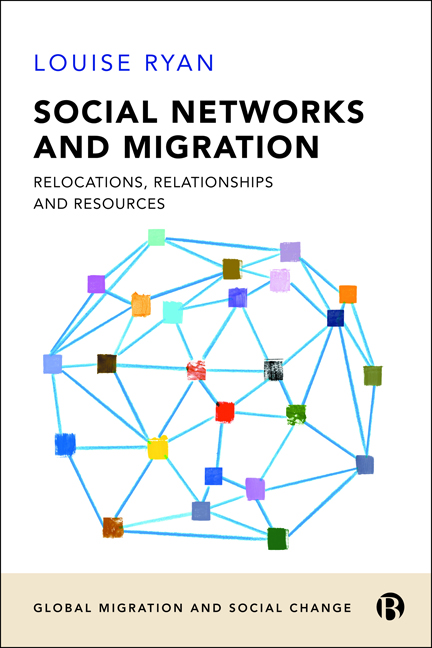Book contents
- Frontmatter
- Contents
- List of Figures
- About the Author
- Acknowledgements
- 1 Introduction: Embarking on a Book about Networks
- 2 Conceptualising Migrant Networks: Advancing the Field of Qualitative Social Network Analysis
- 3 Researching Migration and Networks: Empirical and Methodological Innovations
- 4 Social Networks and Stories of Arrival
- 5 Employment, Deskilling and Reskilling: Revisiting Strong and Weak Ties
- 6 Evolving Networks in Place over Time: A Life Course Lens
- 7 Transnational Ties: Narrating Relationality, Resources and Dynamics over Time
- 8 Conclusion: Thoughts and Future Directions
- Appendix
- Notes
- References
- Index
Appendix
Published online by Cambridge University Press: 18 January 2024
- Frontmatter
- Contents
- List of Figures
- About the Author
- Acknowledgements
- 1 Introduction: Embarking on a Book about Networks
- 2 Conceptualising Migrant Networks: Advancing the Field of Qualitative Social Network Analysis
- 3 Researching Migration and Networks: Empirical and Methodological Innovations
- 4 Social Networks and Stories of Arrival
- 5 Employment, Deskilling and Reskilling: Revisiting Strong and Weak Ties
- 6 Evolving Networks in Place over Time: A Life Course Lens
- 7 Transnational Ties: Narrating Relationality, Resources and Dynamics over Time
- 8 Conclusion: Thoughts and Future Directions
- Appendix
- Notes
- References
- Index
Summary
Irish nurses in Britain in the post-war era (2004– 2005)
Having read in the literature (Walter, 1989) that Irish women made up a significant proportion of migrant workers recruited to work in Britain's newly established NHS in the 1940s and 1950s, I decided to find out more by undertaking a qualitative, oral history study with Irish nurses from the post-war era. I recruited the participants through advertisements in Irish newspapers in Britain, the Irish Post and Irish World, through Irish organisations such as the Federation of Irish Societies and snowballing. 26 semi-structured interviews, informed by oral history techniques, were carried out between October 2004 and August 2005. Most women had arrived in Britain in the 1940s and 1950s, with a few in the 1960s and 1970s. Clearly, those who arrived earlier were in advanced old age by the time of the interviews, with several aged over 80 years. All the women had arrived young and single; most migrated as student nurses aged 18 years or so. All bar one had subsequently married and had children (for more details see Ryan, 2007a; 2007b; 2008b).
Post-accession Polish migration to London
In 2006, as explained in the Introduction, my research embarked in a new direction when I began a study on post-EU accession Polish migration. Along with Rosemary Sales and Mary Tilki, I received ESRC funding (RES-000-22-1552) for the study entitled: Recent Polish Migrants in London: Social Networks, Transience and Settlement. Bernadetta Siara was the research fellow on the project. We conducted three focus groups and 30 individual interviews, with a combined total of 46 participants. The majority were aged between 21 and 39 years old, with approximately 20 per cent aged between 40 and 59. Just over half had children, with a majority of those living with them in London, but almost one quarter of those who were parents had children living in Poland. A number of stakeholder interviews were also conducted with people from Polish community organisations. Thus, over 50 participants were involved in the study (for more details see Ryan et al, 2008; Ryan et al, 2009; Ryan and Sales, 2013).
Muslims in the London Borough of Barnet
The next data set I draw upon in this book is from a study commissioned by Barnet Muslim Engagement Partnership.
Information
- Type
- Chapter
- Information
- Social Networks and MigrationRelocations, Relationships and Resources, pp. 166 - 169Publisher: Bristol University PressPrint publication year: 2023
